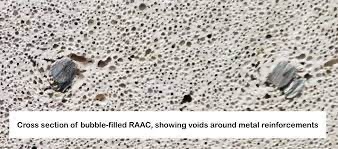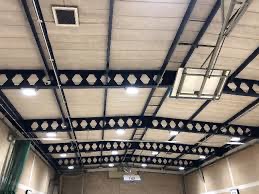We have a spate of reports about closed schools because of failing concrete.
The concrete is called reinforced autoclaved aerated concrete, RAAC. There will be wisecracks about the gov't being on the RAAC and of the state going to RAAC and ruin RAAC was used as a building material from the 1950s. mostly because it was cheap and with the widest use of this material made in the 60s and 70s. All the reporting refers to public buildings – schools, MoD buildings, hospitals and occasionally there is passing mention of other government department buildings. The design advantages of RAAC - which isn't reinforced in the sense of having something like steel rods running through it, but is much more like aerated blockwork—is that it has high insulation values, it is light and, as I already pointed out, it is cheap. So the construction use tended to be as a sort of plank, a lightweight beam of sufficient perceived strength to hold itself up and so it was used in schools primarily as a roofing material. With a lot more support, it could be used for floors, but there are easier alternatives (I think). By 1990 the material was only rarely used and in n 1995 there was a first report of imminent failure of the material, confirmed across the next decade at various sites such that, in 1999, there was a call for all RAAC roofs to be inspected. ¹ Building owners might, quite easily, treat these concretes as insulation with reduced (even irrelevant) structural strength, so I expect a common 'solution' to be to construct a ceiling support (timber, scaffolding, internal support structures) and return the 'failed' room to use.
Later use of RAAC paid attention to the capacity to deteriorate, which, pretty obviously, will be achieved if it is kept dry and at stable temperatures. So internal structural use, one would imagine, would be okay, while there are no dramatic plumbing failures.
So, on the very weekend on which term is expected to begin, there are a load of schools desperately trying to sort out temporary solutions—where 'temporary' is likely to mean a couple of years—to house their students. Classrooms, buildings, wings of larger buildings and so on, are taken 'out of use' because they are declared unsafe. Hospitals have very similar issues and the criticism (maybe various stages of panic) applies to all such buildings in use. The immediate fuss is about schools: I try to sort out the scale of this.
As of 2nd September 2023 (Saturday, expecting term to begin next week) we know now that 14600 schools (primary and secondary) had letters (March 2022) telling them to carry out inspections. ² By December of 2022, the DfE was aware that building failure was likely (think ceilings falling down). By summer 2023 surveys were occurring and the word was out among the civil servants, in the sense that something was being done, though, given the paucity of public money this scarcely went any further than trying to find the extent of the problem for one's own building. This last summer, some 600 detailed surveys were under way in schools and, "out of the 196 completed, 65 found RAAC in various states of repair" ³ If those figures are representative, we're looking at a third, 200 of the 600, moving from the 'no action' state to something closer to panic stations. Action requiring resources to be moved away from education, at the least.
Yes, there have been dramatic failures, since 2018. The useful structural life of the material was declared to be thirty years in 2007; it has not been a secret. What has not happened is responsible spending on maintenance of public buildings. Quoting the same source at ³ and trusting that this source, the Times, is substantially correct, 'between 2016 and 2023 around three quarters of funding for buildings was spent on maintenance and repair' The DfE argued that best practice funding would be £7M; it asked the Treasury for £4M and was given £3.1M. I guess that's the current budgeting. So this is what I've been taught is rentier economics, simply kicking cans down roads, delaying doing anything so that repair is someone else's problem. Which is a false economy since replacement is more expensive than maintenance, but when the issue is political capital connected to capital spending, sensible maintenance is always the loser. Those screaming about improper behaviour should ask themselves if those poor decisions apply also to themselves and their own property (and responsibilities).
RAAC remains a sensible material choice if properly designed, manufactured, installed and maintained. RAAC as used in the 70s and earlier is considered suspect.
Of course, you know already what is going to happen. Huge outcry 'something should be done', lots of finger-pointing and no responsibility accepted where it belongs. A large number of the same students who have had their education stunted by the pandemic are going to have further educational losses and the Powers That Be will decry this at every opportunity while simultaneously doing very little about it, and particularly doing nothing about reducing the damage to that education. The damage is going to last for decades. The repair, refurbishment and replacement is going to last for decades. We're going to have to find the money; we're going to have to recognise that many buildings simply need to be replaced. We're not only talking about schools, but hospitals, prisons, courts, university buildings and so on. I had a look at other users of RAAC and found that it was widely used in social housing projects (Telegraph reporting).


I wonder how many are confused that cement is found inside the word reinforcement. Here is a cross-section of an RAAC concrete plank, two rods included in the length of the beam. I expect that the rods are shorter than the entire beam by 50-100mm, so as to give adequate concrete cover (so the reinforcement doesn't rust or things like that).
The concrete planks or beams typically come with a chamfered edge as shown here so that, in use these materials might be recognised by the groove (two edges together). See the DfE identification document [3].
¹ Specifically, the Standing Committee on Structural Safety called for all RAAC roofs to be inspected again. The material responds to repeated wetting and heating, as happens to roofs, by degradation; beams deform, they lose structural strength and these conditions can cause beams to fall (which is a form of failure with consequences).
² Specifically, schools built between 1930 and 1990 were told to find out if they had RAAC in the building, to be aware that the life of the material was to be considered as thirty years and to plan for replacement. Fewer than half did checks and the DfE concluded that some 700,000 students were affected, being in buildings in need of major rebuilding work. Note , please, that we simply don't know about the half that didn't find out any more than we know much about the other state properties in need of significant maintenance.
³ I'm quoting the Times report of Sat 20230902, pages 6&7, throughout this piece.
[1] https://www.local.gov.uk/topics/housing-and-planning/information-reinforced-autoclaved-aerated-concrete-raac Worth a read; this is what a building maintainer would find.
[2] https://www.cross-safety.org/uk/safety-information/cross-theme-page/structural-safety-reinforced-autoclaved-aerated-concrete-raac-planks explains how RAAC should be used (bituminous or a cement latex coating on the reinforcement) I have not (yet) found an explanation of what the expected reinforcement is, but it isn't in the concrete blocks. Don't confuse RAAC with ordinary areated concrete blocks, blockwork such as is commonly used for the inside leaf of cavity walls, where it is kept stable by the outer leaf of the wall. Cross-Safety leads you to other current pages about RAAC.
Don't confuse RAAC with other reinforced concrete. The issue, I think, is that the steel reinforcement often doesn't extend far enough within the beam, so that insufficient support length has been used. I am certainly finding many things that are NOT RAAC attached to text that refers to RAAC.
[3] https://assets.publishing.service.gov.uk/government/uploads/system/uploads/attachment_data/file/1182192/GUIDE-DFE-XX-XX-T-X-9002-Reinforced_Autoclaved_Aerated_Concrete_Identification_Guidance-A-C02.pdf DfE identification document – what a Head would be looking for.
From Private Eye, #1606, p28;
What is the difference between RAAC and RAAB?
One is dense, full of hot air, long past its expected useful life. The other is a type of concrete.
GCSE Maths exam
1. Your school was built in 1982. if the aerated concrete it is made from was designed to last 30 years, what year would be sensible to take some action to prevent it collapsing?
a) 2010 b) 2020 c) 2023, on the day before term starts
_________________________
_________________________
_________________________
_________________________
_________________________
_________________________
_________________________
_________________________